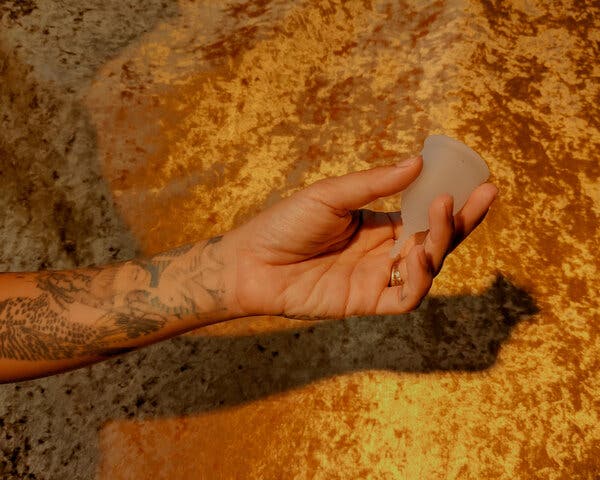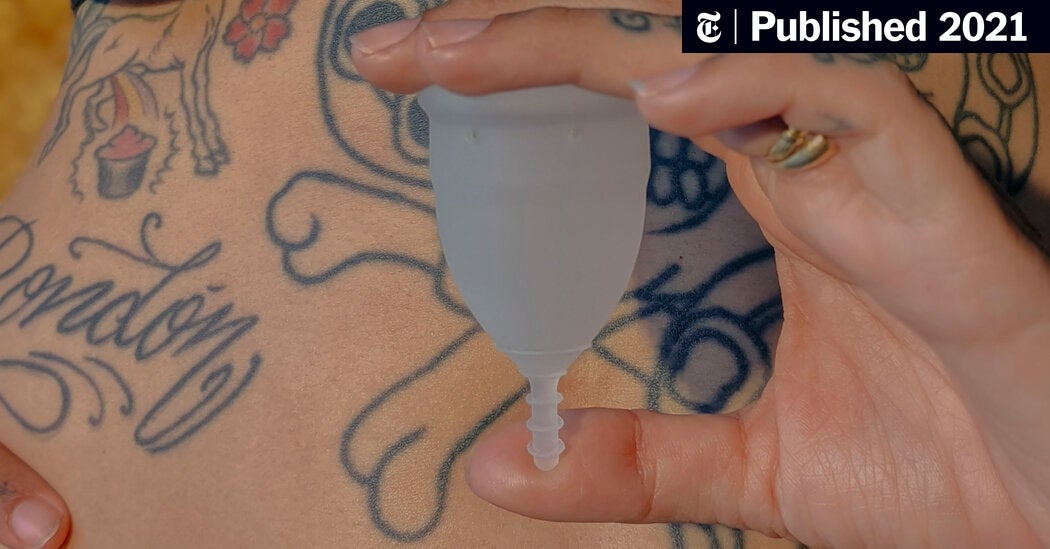Consider the menstrual cup.
A repository for bodily fluid, it was first patented in 1867, a half-century before the commercial tampon arrived, and even a decade before the pad. A rubber model appeared in the 1930s, but its prevalence was curtailed by World War II, when rubber was in short supply. Enter the disposable tampon, which has dominated since.
Now a team of design curators, health care practitioners and advocates want you to reconsider the menstrual cup, remove it from the still pink-hued feminine hygiene aisle, and look at it as an object, not of private utility, but of beauty. It sure beats a wad of cotton.

An example of a menstrual cup held by Marilyn Rondon, an artist who modeled for four of the photographs in this article. She gave birth to her first baby in November.Credit...Natalia Mantini for The New York Times
Designs vary, but in its most common iteration, it is bell-shaped and elegant, flexible, durable and washable. Its history is tied to fashion: the first commercial cup was devised by Leona W. Chalmers, a onetime Broadway star who created it because she wanted to wear her costumes of white silk without fear. Chalmers was ceaseless in championing her version for “modern women,” and, it seemed, she was far ahead of her time: the cup has recently proliferated, with sales gaining momentum. Tampax introduced its own version in 2018.
Advertisement
Continue reading the main story
“What makes it so beautiful also, it’s affordable, it’s environmentally conscious — it’s just one object that one needs, rather than a lifetime of buying pads and tampons to discard,” said Amber Winick, a design historian. Winick and Michelle Millar Fisher, a curator of contemporary decorative arts at the Museum of Fine Arts, Boston, believe that the menstrual cup is museum-worthy, along with the breast pump, the speculum and the IUD — devices that normally are not valued for their aesthetics and are often culturally invisible.
Their provocative new book and exhibition series, “Designing Motherhood: Things That Make and Break Our Births,” makes the case that there is a whole world of objects pertaining to women, mothers and pregnant people that have been overlooked from the perspective of form and function, and unstudied in terms of how their designs came to be.
“Why,” the organizers write, have these artifacts “remained so hidden, even as they define the everyday existence of so many?”
It is, in part, a problem of perspective and access, Millar Fisher added in an interview. “These objects are often used by people who have not had the power to write history, make decisions or frame material culture,” she said. “They have just not been part of the conversation, out loud, until recently.”
Advertisement
Continue reading the main story
“Designing Motherhood” begins with a small exhibition, which opened in Philadelphia in May at the Mütter Museum, a medical museum known for its collection of anatomical oddities. A larger exhibition is to open in September at the Center for Architecture and Design in Philadelphia. The pandemic meant the two exhibitions no longer ran concurrently, as originally planned, but the idea was always to blend audiences from science, medicine and design, organizers said. The duo worked with Juliana Rowen Barton, a curator and historian focused on the intersection of gender, race and design, and Zoë Greggs, an artist and curatorial assistant, and partnered with Maternity Care Coalition, a community nonprofit in Philadelphia that primarily helps low-income families, as they developed their project.
Its cornerstone is a book, due in September from M.I.T. Press. In sections devoted to reproduction, pregnancy, birth and postpartum life, it winds through social and medical history, highlighting innovations, like a sleek new concept for the speculum, and inventions of necessity, like the Del-Em, a 1971 “menstruation extraction” device, still adapted for abortions today. Both are on view at the Mütter Museum.
The authors also take on changing ideologies: one midwife they feature has done away with medical stirrups in her practice, for example, using guidance on how to examine people who are in wheelchairs or otherwise differently mobile. As it turns out, the gynecologist’s stirrup — used for the convenience of doctors, but for ages a shorthand for the discomfort of women on the exam table — need not be the standard.
The female form is almost certainly one of the most visualized parts of art, and among the most represented in collections. Yet “museums neglecting designed objects that address the needs of women's bodies is not an accident,” Alexandra Cunningham Cameron, curator of contemporary design at the Cooper Hewitt, Smithsonian Design Museum, said in an email. “Rather, it’s symptomatic of an historically male dominated curatorial and industrial design field; of a culture that prioritizes fantasy over biology; that privatizes birth; that commodifies women's bodies. Design museums are in a unique position to illuminate social and historical inequities and advancements through product innovation, but still hesitate.”

 www.nytimes.com
www.nytimes.com
A repository for bodily fluid, it was first patented in 1867, a half-century before the commercial tampon arrived, and even a decade before the pad. A rubber model appeared in the 1930s, but its prevalence was curtailed by World War II, when rubber was in short supply. Enter the disposable tampon, which has dominated since.
Now a team of design curators, health care practitioners and advocates want you to reconsider the menstrual cup, remove it from the still pink-hued feminine hygiene aisle, and look at it as an object, not of private utility, but of beauty. It sure beats a wad of cotton.

An example of a menstrual cup held by Marilyn Rondon, an artist who modeled for four of the photographs in this article. She gave birth to her first baby in November.Credit...Natalia Mantini for The New York Times
Designs vary, but in its most common iteration, it is bell-shaped and elegant, flexible, durable and washable. Its history is tied to fashion: the first commercial cup was devised by Leona W. Chalmers, a onetime Broadway star who created it because she wanted to wear her costumes of white silk without fear. Chalmers was ceaseless in championing her version for “modern women,” and, it seemed, she was far ahead of her time: the cup has recently proliferated, with sales gaining momentum. Tampax introduced its own version in 2018.
Advertisement
Continue reading the main story
“What makes it so beautiful also, it’s affordable, it’s environmentally conscious — it’s just one object that one needs, rather than a lifetime of buying pads and tampons to discard,” said Amber Winick, a design historian. Winick and Michelle Millar Fisher, a curator of contemporary decorative arts at the Museum of Fine Arts, Boston, believe that the menstrual cup is museum-worthy, along with the breast pump, the speculum and the IUD — devices that normally are not valued for their aesthetics and are often culturally invisible.
Their provocative new book and exhibition series, “Designing Motherhood: Things That Make and Break Our Births,” makes the case that there is a whole world of objects pertaining to women, mothers and pregnant people that have been overlooked from the perspective of form and function, and unstudied in terms of how their designs came to be.
“Why,” the organizers write, have these artifacts “remained so hidden, even as they define the everyday existence of so many?”
It is, in part, a problem of perspective and access, Millar Fisher added in an interview. “These objects are often used by people who have not had the power to write history, make decisions or frame material culture,” she said. “They have just not been part of the conversation, out loud, until recently.”
Advertisement
Continue reading the main story
“Designing Motherhood” begins with a small exhibition, which opened in Philadelphia in May at the Mütter Museum, a medical museum known for its collection of anatomical oddities. A larger exhibition is to open in September at the Center for Architecture and Design in Philadelphia. The pandemic meant the two exhibitions no longer ran concurrently, as originally planned, but the idea was always to blend audiences from science, medicine and design, organizers said. The duo worked with Juliana Rowen Barton, a curator and historian focused on the intersection of gender, race and design, and Zoë Greggs, an artist and curatorial assistant, and partnered with Maternity Care Coalition, a community nonprofit in Philadelphia that primarily helps low-income families, as they developed their project.
Its cornerstone is a book, due in September from M.I.T. Press. In sections devoted to reproduction, pregnancy, birth and postpartum life, it winds through social and medical history, highlighting innovations, like a sleek new concept for the speculum, and inventions of necessity, like the Del-Em, a 1971 “menstruation extraction” device, still adapted for abortions today. Both are on view at the Mütter Museum.
The authors also take on changing ideologies: one midwife they feature has done away with medical stirrups in her practice, for example, using guidance on how to examine people who are in wheelchairs or otherwise differently mobile. As it turns out, the gynecologist’s stirrup — used for the convenience of doctors, but for ages a shorthand for the discomfort of women on the exam table — need not be the standard.
The female form is almost certainly one of the most visualized parts of art, and among the most represented in collections. Yet “museums neglecting designed objects that address the needs of women's bodies is not an accident,” Alexandra Cunningham Cameron, curator of contemporary design at the Cooper Hewitt, Smithsonian Design Museum, said in an email. “Rather, it’s symptomatic of an historically male dominated curatorial and industrial design field; of a culture that prioritizes fantasy over biology; that privatizes birth; that commodifies women's bodies. Design museums are in a unique position to illuminate social and historical inequities and advancements through product innovation, but still hesitate.”

Menstrual Cups in Museums? It’s Time. (Published 2021)
Objects designed for birth, fertility and parenthood have long been neglected by institutions. A new book and exhibition series aims to change that.


